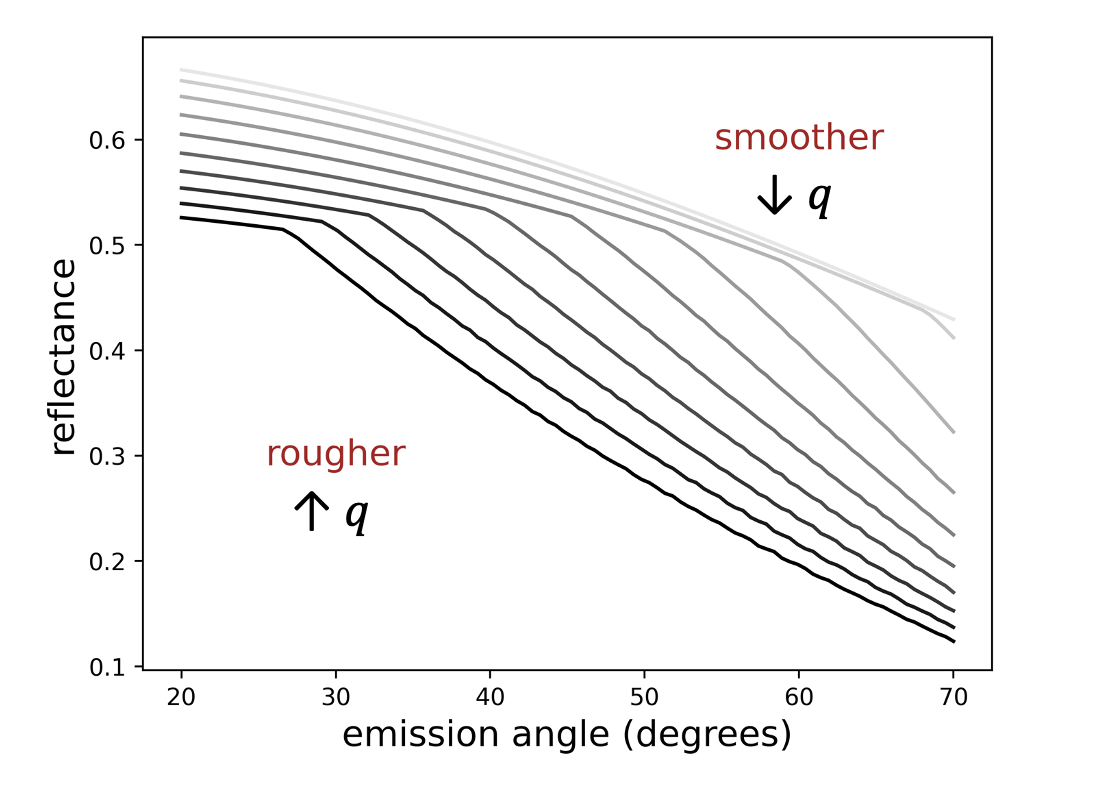
Macroscopic roughness of a planetary surface encompasses facets ranging in size from aggregates of particles to mountains, craters and ridges. These features alter the reflected light from a planetary surface in two ways: the local incidence and emission angles are changed by alteration of the surface profile from that of a smooth sphere, and they remove radiation from the scene by casting shadows. The primary effect of this on the reflectance curves is a characteristic downturn at higher angles, as seen in the models in the left figure. Since this effect is scale-independent, quantifying roughness via photometry can help us peer below the resolution limit of camera images, and connect the quantifiable roughness across planetary surfaces to the processes affecting surface evolution, such as space weathering and volatile transport.
Investigating the extent of bladed terrain on Pluto via
photometric surface roughness

NASA's New Horizons spacecraft observed fields of sub-parallel sets of steep ridges situated in high-altitude, low-latitude regions of Pluto called 'bladed terrain'. Thought to be formed due to sublimational erosion of methane ice, bladed terrain represents an active response of Pluto's landscape to current and past climates. The observation of a strong methane signature within the low latitudes of Pluto's non-encounter hemisphere points to the possibility that this terrain type is also present there. To test this hypothesis, in absence of high resolution of images of Pluto's non-encounter hemisphere, I employed photometric analysis of the methane rich regions, both in the encounter and non-encounter hemispheres of Pluto (shown in red in the figure above). I found that the hypothesized bladed terrain region on the non-encounter hemisphere of Pluto is very rough (𝑞 = 0.48 (−0.11)(+0.10), where 𝑞 is a roughness parameter), around twice as rough as the encounter-hemisphere bladed terrain region (𝑞 = 0.2(−0.18)(+0.08)) and six times as rough as the visibly smooth Sputnik Planitia (𝑞 = 0.07(−0.06)(+0.14), shown in blue in the figure above).
Publication(s): Mishra et al., Investigating the extent of bladed terrain on Pluto via photometric surface roughness, 2023, in review, Geophysical Research Letters
Selected Presentation(s): JPL Research Day 2023 Poster
Determination of Macroscopic Roughness of Dimorphos Using a Disk-Resolved DART Image

DART crashed into Dimorphos, companion of asteroid (65083) Didymos, on 26 September 2022. Right before the crash, the camera DRACO took close-up images of Didymos. These images provide us a unique opportunity to study the scattering properties of the asteroid via photometry. I was part of a team, led by Dr. Bonnie Buratti, that performed the first comprehensive photometric analysis of Dimorphous, where I specifically led the photometric roughness analysis. The reflectance data seems to be divided into two populations with distinct roughness: a low roughness terrain at smaller emission angles, and a high roughness terrain at larger emission angle (left and middle panels in the figure above). Meanwhile, the albedo map of Dimorphos (right panel in the figure above) shows high albedo striations, which could have been formed from an impact. The roughness I derive correlates with these albedo variations: the surface appears to be substantially smoother towards the ends of the radiating striations, perhaps due to
infilling of dust from the impact that formed the striations. These smooth areas mixed with boulders could be causing two different populations of roughness to appear in the reflectance data.
Publication(s): Buratti, B. J., Pittichova, J., Mishra, I., & 11 co-authors, Pre-impact albedo map and photometric properties of Dimorphos from DART and ground-based data, 2023, in review, Planetary Science Journal
Selected Presentation(s): DPS 2023 Meeting Poster



